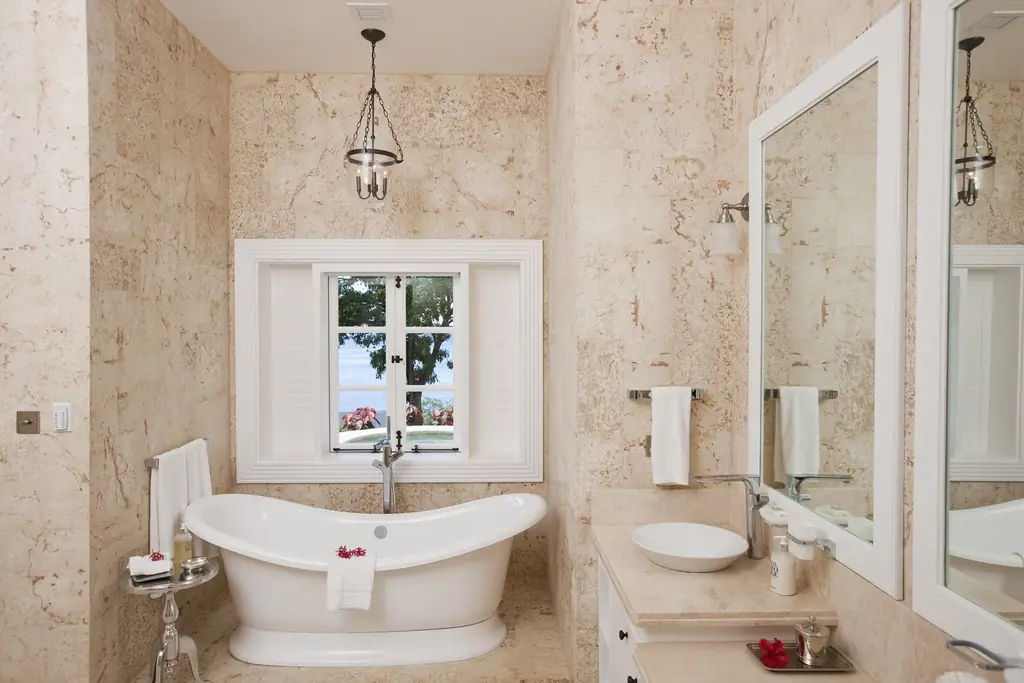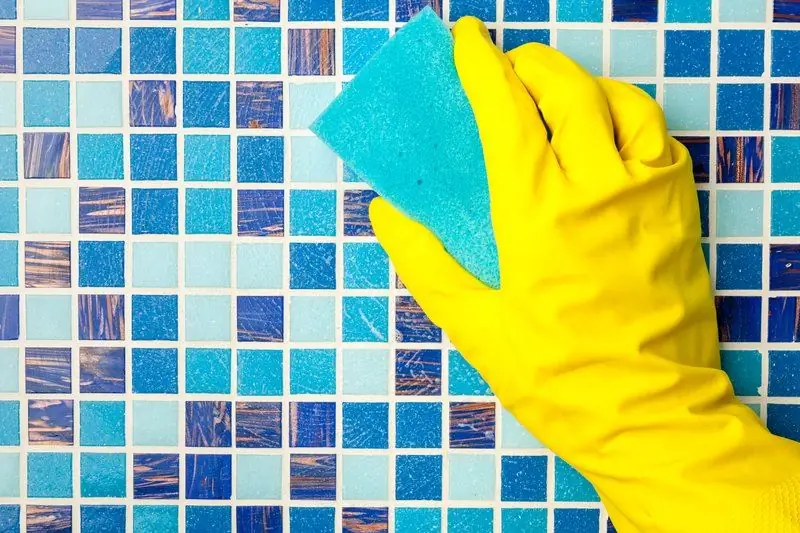
Table of contents:
- Author Bailey Albertson [email protected].
- Public 2023-12-17 12:53.
- Last modified 2025-01-23 12:41.
Home master class. How to lay tiles on the bathroom floor

Currently, the most practical type of bathroom floor is ceramic tiles. Such a floor is easy to care for, it continues to look very good for a long time. After proper preparation, ceramic tiles can be laid on almost any substrate. And today, continuing the cycle of articles on bathroom renovation on our website "Do it yourself with us", we will talk about how the tiles are laid on the floor.
All operations will be done in the following sequence:
- Preparing the surface.
- We decide on the design of the floor and choose ceramic tiles.
- We are planning the laying of tiles on the floor.
- We make styling.
- We rub the seams.
Content
- 1 Preparing the surface
- 2 We decide on the design of the floor and choose ceramic tiles in the bathroom
- 3 Planning the laying of tiles
- 4 We make styling
- 5 Rubbing the seams
Preparing the surface
Since we make repairs with our own hands in the bathroom, it is initially assumed that we already have some kind of floor. We need to bring this floor into proper form.
And the first step in surface preparation will be to determine how well this floor is well laid. In my case, it was the classic version for the bathrooms of the Soviet period, the floor was paved with "brown pig" - the most common floor finish of those times. Basically, since the tile was laid on a cement mortar, it holds very poorly and is laid very crookedly.
We arm ourselves with a chisel, a hammer, a sledgehammer and goggles - we remove all the old tiles. This is not a very difficult matter, the main difficulty is to knock down the cement baseboard around the perimeter of the bathroom and make the surface flat.
The second step is to determine how horizontal the surface is.
To do this, at a convenient height on the wall, we put a horizontal mark. (I, since I tiled the bathroom with tiles completely, combined this procedure with marking the horizontal rows of tiles on the walls). Using the hydro level, we transfer the height of this mark to all 4 walls of the room in such a way as to draw a solid horizon line on the wall along the entire perimeter of the room. We measure from this line the distance to our floor. Ideally, the distances on all 4 walls should be equal, which means that the floor is horizontal and nothing needs to be done.
In my case, when checking the floor for horizontalness, a height difference at the floor level of 1.5-2 cm was found, although the size of the bathroom is very small 1.45 m. wide and 2.2 m long. For such a small room, I think this is a big difference. Moreover, the highest level was in the opposite corner diagonally relative to the lowest. All this needed to be fixed:
- in the highest place we retreat from the floor a distance equal to the thickness of the floor tiles plus the thickness of the seam. This is approximately 1 cm in total;
- put a horizontal mark on the wall;
- we measure the distance from our mark to the horizon line, which we drew earlier;
- we transfer this distance from the horizon level along the entire perimeter of the room;
- we draw our new floor horizon, this will be the final height of our new floor.
If, in your case, the difference in height will turn out to be significant (more than 2 cm without taking into account the thickness of the tile), it will be necessary to level the surface first. This is done using a special floor leveler - self - leveling floor, or, if the difference is very large, using a cement screed with beacons.
In my case, the drop was not very large, and I decided to remove it by changing the thickness of the adhesive layer under the tiles.
The third stage is to finally prepare the surface. It must be well cleaned, any loose elements, grease and oil stains must be removed, and dust must be vacuumed. It is advisable to prime porous surfaces.
We decide on the design of the floor and choose ceramic tiles for the bathroom
There are a lot of ways to lay tiles on the floor. It all depends on your room, its size, lighting, furniture arrangement, plumbing fixtures and much more. You can lay the tiles in the classic seam-in-seam method with clear rows in the longitudinal and transverse directions parallel to the walls.
They use the method of laying the tiles apart, for example, only the longitudinal seams coincide, and the transverse ones go with an offset.
You can apply the diagonal stacking method, i.e. the seams in the longitudinal and transverse directions will be parallel to the diagonals of the room.
Having a large room, it will be advisable to lay out some kind of drawing on the floor. This will decorate the floor very well and will bring a certain unique flavor.

At the same stage, you need to think about what size tile you want to see. If the bathroom is not very large, it will be advisable to choose a small tile.
If you want to save on the cost of materials, then you need to correlate the size of the tiles and the size of the room. For example, with a room width of 3 meters and a length of 3 meters, it would be more expedient to choose a tile measuring 30 cm * 30 cm. When laying it, there will be no waste at all, all the tiles will be intact, and, accordingly, the floor will look very impressive. And vice versa, if you choose a tile of 33 cm * 33 cm, then there will be a lot of pruning, and accordingly there will be a lot of waste.
We plan the laying of tiles
We bought the tiles, we are starting the installation process itself. Most of the tiles produced are square, or at least rectangles with 90˚ corners. Most of the rooms, however, are far from being square. Most of the walls have deviations, both from the straightness of the walls, and from the verticality, the internal corners are very rarely 90˚. And there can be many such flaws in construction. This does not mean that your house was built badly, it is quite normal.
It is necessary to mark the tile laying so that:
- in the most conspicuous place (for example, at the entrance to a room or a place where the eye immediately falls) the tile was parallel to the wall and was not cut;
- regardless of the position of the walls (walls can also form an irregular rhombus), the laid tile formed a regular square (or rectangle);
- the tile was cut in the most invisible place (for example, under the bathroom);
- after laying the main surface in the places where the floor adjoins the walls, narrow strips for insertion were not obtained, because cutting a very narrow strip from a tile is problematic. It is better to move the whole drawing a little to another wall.
Based on these principles, in my bathroom, I preliminarily laid out one row along and one row across the room. I oriented the rows in a regular rectangle relative to the wall with the entrance. The goal was: at the entrance to put a whole tile at the level of the floor of the entire apartment room, cut to the right of the entrance (under the bathroom) and place whole (uncut) tiles to the left of the entrance.


For the correct orientation of the rows in the longitudinal direction, we measure the distance from the wall to our row at the beginning of the row and at the end. The distances must be equal. If necessary, adjust the row slightly by offsetting it. We achieve parallelism of the row to the wall.


We draw the position of the longitudinal and transverse rows and remove the tiles.

This is where the preparatory stage ends. We decided on the rows, the location of the tiles, the floor height. In my bathroom, I started laying with a whole tile of a whole (not cut) extreme row, which is located opposite the entrance - to exactly match the floor level in the bathroom with the floor level of the entire apartment.
We make styling
To lay the tiles, we need the following tool: a hammer with a rubber impact part, 2 levels (long and short), a tool for cutting tiles, a marking pencil, a ruler, a notched trowel, an ordinary spatula, a container for making glue, crosshairs for seams.
The tiles can be laid as on ready-made glue (sold in buckets, already diluted and ready for use), or you can prepare the glue solution yourself by purchasing it in dry form. I used dry powder.

It is easy to dilute according to the instructions on the package. Until you have skills in work, do not breed a large amount, it is better to add a little later.
We lay the first tiles according to our markings, check their horizontality in the longitudinal and transverse directions.

To exactly match the floor level in the bathroom and the floor level in the entire apartment, I put the next tile adjacent to the entrance. We check the floor level according to our drawn marks of the finished floor height on the wall and, if necessary, slightly adjust our three tiles in height.

Setting up the first guide tiles is the most difficult and time-consuming step. After its completion, we lay the tiles in a row up to the wall in one direction.

And up to the wall in the other direction. We orientate the horizontal row according to our three exposed tiles and the marks of the finished floor height on the wall.

We lay the first extreme, but always the whole tile, of the next row.


We align it with our already existing row, applying a level in the longitudinal and transverse directions. We achieve a uniform floor plane and insert a seam cross to maintain the identity of the seams. We leave all the tiles that will be trimmed to the end.

We spread the entire second row, and expose the outermost whole tile of the third row, similar to the previous procedure.

The procedure for laying out tiles in a row is as follows:
We put the tiles close to the two already laid. Align the tiles horizontally with respect to these two tiles.

We apply a level in the transverse direction of the row and achieve a plane, similarly in the longitudinal direction of the row. We check the horizontality along the diagonal so that the free corner of the tile does not climb up. Insert the seam crosses and set the straightness of the seams.

We check that the junction of the four tiles is at the same level and that more than one corner does not stick out.

It is advisable after these operations to see how the laid tile looks in the general background, whether the seams are straightforward. Thus, we lay out all the whole (which are not trimmed) floor tiles.
And the last step will be the laying of the extreme tiles that fit the walls. They will all be trimmed in a certain way, so it will be advisable to first cut and number them all, and then put them in place. When marking, it is imperative to take into account the width of the joint between the tiles.

It is convenient to do this whole procedure after the bulk of the laid tile has finally risen and the glue under it has hardened. This will allow you to walk freely on the floor and mark all the tiles you cut. How to cut tiles and how to drill holes of different diameters, I wrote in detail in the following articles. This is not a very complicated matter, but you cannot do without it.
We rub the seams
The last step in laying tiles on the floor will be grouting. In the bathroom, it is imperative to pick up a moisture-resistant grout that can withstand repeated wetting. How to choose it, what colors to choose and how to fill the seams correctly is a separate and very multifaceted topic. I plan to cover it in the next article.
Putting all the tiles around the perimeter of the room and filling in the seams, we get this picture of the finished floor.

Laying tiles on the floor is a tricky task, but with the right planning and good preparation, it is much easier and no longer seems impossible. Acting carefully, slowly and enjoying your work, you are guaranteed a great result.
Approaching such serious types of work as laying tiles, I always say to myself: “I do not need to fulfill the plan and lay twenty square meters in one day. I do not receive a salary from the work here. Here I get pleasure from the work done with my own hands."
Approach difficult things for repairs in the same way, and everything you will have to argue and move forward very, very quickly.
In the article, I tried to describe in as much detail as possible the process of how to put tiles on the floor in my small bathroom. You may have some of your own nuances and features. Do not be intimidated, approach difficulties creatively, apply creative solutions.
Good luck with the renovation work.
Recommended:
How To Properly Lay Linoleum On A Wooden, Concrete Floor, On Plywood With Your Own Hands In An Apartment, In A Room + Installation Video

Laying linoleum on the floor in an apartment with your own hands. How to properly lay material on different types of floors, without moving furniture, and cut it to the walls
How And What To Clean The Tiles In The Bathroom From Plaque At Home: Rules For Effective Cleaning Of Tiles

How to effectively clean the tiles in the bathroom. How to remove plaque from tiles and give them shine. Effective means, tips, instructions
Laying Tiles On The Wall Or How To Lay Tiles On The Wall

Laying tiles on the wall in the bathroom with your own hands. How to correctly and easily put tiles on the walls when making repairs in the bathroom with your own hands
How To Choose Bathroom Floor Tiles: An Overview Of Options

How to choose floor tiles for your bathroom. Overview of options: ceramic tiles, porcelain stoneware, natural stone, fired clay tiles and mosaics
DIY Bathroom Repair: Step-by-step Instructions For Overhauling A Bathroom

Complete bathroom overhaul step by step instructions. We do bathroom repairs with our own hands. Repair cost calculation
